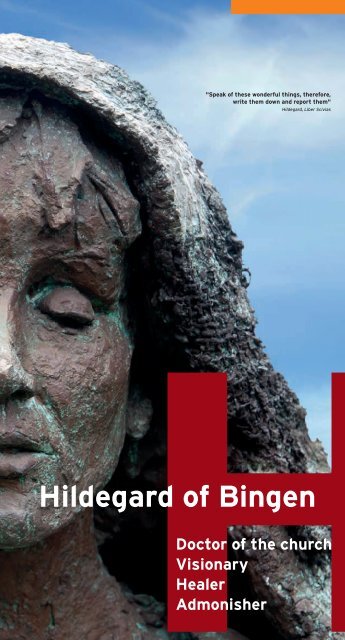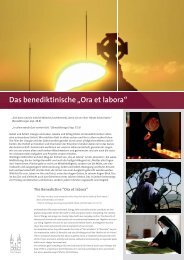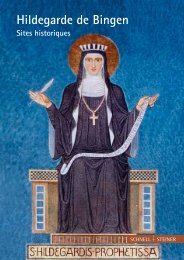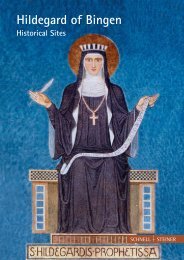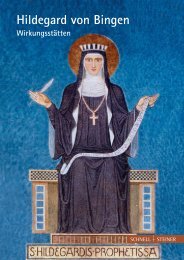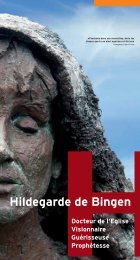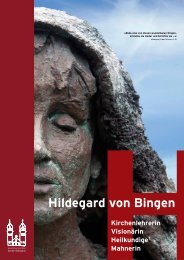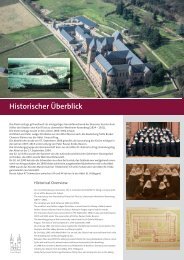hildegard_english_final
You also want an ePaper? Increase the reach of your titles
YUMPU automatically turns print PDFs into web optimized ePapers that Google loves.
"Speak of these wonderful things, therefore,<br />
write them down and report them"<br />
Hildegard, Liber Scivias<br />
Hildegard of Bingen<br />
Doctor of the church<br />
Visionary<br />
Healer<br />
Admonisher
Biography<br />
For me Hildegard is a strong, prophetic figure –<br />
a window to heaven, to transcendence. She<br />
teaches us that the love of God, love of creation,<br />
love of humankind and love of the Church belong<br />
together. Hildegard’s criticism was always<br />
constructive, it was rooted in her love of the<br />
Church and helped to build up the Church. Her<br />
passionate dedication urges all Christians,<br />
clergy and religious to be credible. Saint<br />
Hildegard is a mentor and companion for me.<br />
Clementia Killewald OSB<br />
Abbess, Abbey of St Hildegard<br />
1098<br />
ca. 1106<br />
1112<br />
1136<br />
1141–1151<br />
1147/1148<br />
1150<br />
1147–1179<br />
1158<br />
1158–1170/1<br />
1158–1173<br />
1163<br />
1165<br />
1173<br />
1174/1175<br />
1178/1179<br />
1179<br />
1180–1190<br />
1227<br />
1632<br />
1802<br />
1904<br />
2012<br />
Hildegard is born in Rhine-Hesse (region<br />
southwest of Mainz)<br />
Hildegard is placed in Jutta of Sponheim’s care<br />
for education<br />
Hildegard enters an enclosed cell at<br />
Disibodenberg<br />
Death of Jutta of Sponheim<br />
Hildegard is elected Magistra<br />
Work on her first book, Liber Scivias,<br />
composition of songs and a musical drama<br />
Pope Eugene III confirms Hildegard’s visionary<br />
gift<br />
Move to the new monastery at Rupertsberg<br />
near Bingen<br />
Extensive correspondence with popes, bishops<br />
...<br />
Deed of ownership of Rupertsberg<br />
Public preaching at Mainz, Trier, Cologne and<br />
other places<br />
Work on her books Liber Vitae Meritorum,<br />
Physica and Causae et Curae and Liber<br />
Divinorum Operum<br />
Meeting with the Emperor Frederick<br />
Barbarossa at Ingelheim<br />
Hildegard founds a second monastery at<br />
Eibingen, of which she is also abbess.<br />
Hildegard’s secretary Volmar dies<br />
The monk Godfrey begins to write the Life of<br />
Hildegard<br />
Hildegard comes into conflict with the<br />
diocesan administrators of Mainz<br />
Hildegard dies on 17 September<br />
The monk Theodoric completes the Life of<br />
Hildegard<br />
First petition for her canonization<br />
The monastery at Rupertsberg is destroyed<br />
during the Thirty Years’ War<br />
Dissolution of the monastery at Eibingen<br />
during the Secularization<br />
The Abbey of St Hildegard is newly founded<br />
Canonization and Proclamation of Hildegard of<br />
Bingen as a Doctor of the Church
The Twelfth Century<br />
Hildegard was born at a time of upheaval and far-reaching<br />
changes. The climate was warming, the population<br />
increased. New arable land was claimed, rural settlements<br />
and towns develop. People became more mobile. New<br />
methods in agriculture and specialisation in craftsmanship<br />
and trade facilitate the better provision of people. Goods<br />
were transported over long distances. The guilds, a new<br />
form of society, came into existence. The use of coinage<br />
gradually replaces barter. Written documentation in<br />
everyday life attains a higher significance.<br />
The cultural life of this era is characterized by the flowering<br />
of Romanesque art with the Gothic period beginning in<br />
France. First universities are founded in Paris and Bologna<br />
at an age when providing access to higher education is still<br />
the privilege of monasteries. The crusades accelerate the<br />
encounter of different cultures. Writings in Greek and<br />
Arabic (for instance on philosophical and medical subjects)<br />
reach the Western world.<br />
For me Hildegard of Bingen is a woman, who was<br />
able to realize her talents and bring them to<br />
fruition in a very special way, which in her day<br />
required tremendous courage and profound faith in<br />
God, but also confidence in herself. Were she alive<br />
today, she might perhaps be a brilliant scientist or<br />
a Mother Teresa. In her, both came together. Her<br />
inquisitiveness about the world that surrounded<br />
her and which she wanted to understand, as well as<br />
her dedication to the infirm and those in need. She<br />
rejoiced in God’s creation, but was stern with those<br />
who would not respect and honour it.<br />
Margarethe von Trotta<br />
The Church, too, is undergoing change. In 1054 Rome and<br />
Byzantium seperate. Christendom is now divided into a<br />
Western and an Eastern Church. The Investiture<br />
Controversy rages between pope and emperor over the<br />
right to appoint bishops. The first crusade sets off for the<br />
Holy Land in 1096. Deplorable internal conditions (simony,<br />
married clergy, moral decline and excessive wealth) present<br />
a threat to the Church. This leads to a change of thought in<br />
the Church and a desire for reform: the Gregorian Reform,<br />
the foundation of new orders, itinerant preachers, the sect<br />
of the Cathars are all reactions to the condition of the<br />
Church.<br />
When she was about 14, Hildegard‘s parents<br />
committed her to the monastic life. Hard though<br />
this is to imagine today, in Hildegard’s time this<br />
was a privilege. To be able to enter a monastery<br />
was an opportunity open to a select few – most<br />
often members of the nobility. – Only life in a<br />
monastery offered the possibility of an excellent<br />
education and continued training.
The Sites<br />
The canonization of Hildegard of Bingen is a<br />
significant development for the Universal Church. I<br />
am delighted that this outstanding person, who is<br />
already held in high esteem in our country, has now<br />
received further recognition. The Abbey of St<br />
Hildegard at Eibingen has become an important<br />
place of pilgrimage and a Hildegard Centre in<br />
Germany. I am grateful that the veneration of St<br />
Hildegard in the Benedictine Order, at the Abbey of<br />
St Hildegard and in the dioceses of Mainz, Trier and<br />
Limburg bears such abundant fruit.<br />
Robert Zollitsch<br />
Archbishop em. of Freiburg<br />
Disibodenberg<br />
Hildegard began her life at Disibodenberg<br />
on 1 November 1112. The women in the<br />
hermitage followed a strict monastic life<br />
according to the Rule of Saint Benedict.<br />
Hildegard received a well-founded, broad monastic education<br />
from her mentor, Jutta of Sponheim: She learned to read, write<br />
and sing, acquired comprehensive knowledge of the Scriptures,<br />
but also closely studied nature, in particular herbs and plants.<br />
At Disibodenberg she wrote her first book, Liber Scivias. In<br />
1147/48 Pope Eugene III was residing at Trier and heard about<br />
Hildegard. He had her visionary gift examined by a commission<br />
and confirmed it.<br />
In a letter he bade her continue with her writing. For Hildegard<br />
this was endorsement, encouragement and stimulation. For<br />
those around her it was definitive proof that the Magistra of<br />
Disibodenberg really was “God’s trumpet”. While all of this was<br />
happening, Hildegard also pursued her intention of founding her<br />
own monastery.<br />
Rupertsberg<br />
Hildegard purchases land at<br />
Rupertsberg near Bingen and with her<br />
nuns built a monastery based on her<br />
own concept. They relocated between<br />
1147 and 1151. A charter in the name of Henry, archbishop of<br />
Mainz, dated 1 May 1152, documents the consecration of the<br />
church. There was a dispute with the abbot of Disibodenberg<br />
concerning Rupertsberg’s independence and its possessions.<br />
Hildegard made use of her good connections and received deeds<br />
which largely safeguard her monastery’s independence. In 1632<br />
Rupertsberg was destroyed during the Thirty Years’ War.<br />
Eibingen<br />
Hildegard’s fame drew many to seek admission at<br />
Rupertsberg. Soon the monastery was too small.<br />
She bought a vacated monastery at Eibingen. It<br />
was rededicated in 1165. Hildegard also became<br />
abbess of this second monastery and crossed the<br />
Rhine twice a week to visit the sisters at Eibingen.<br />
In 1802, as a result of the Secularization, the monastery was<br />
dissolved; all its possessions were lost. In 1831 the monastic<br />
church became the parish church of Eibingen.<br />
New Foundation of the Abbey of St Hildegard<br />
In 1904, after a four years of building, 14 nuns of the<br />
Abbey of St Gabriel in Prague move into the newly<br />
built monastery high above the Rhine. The<br />
monastery is raised to the full status of an abbey<br />
and endowed with all rights and privileges of<br />
Hildegard’s former monasteries. It is exempt<br />
from local episcopal authority and is placed<br />
directly under the jurisdiction of the Holy See.<br />
The community of the Abbey of St Hildegard<br />
regards the study of and care for Hildegard’s<br />
legacy as its pre-eminent concern, passing it<br />
on to contemporaries as a timelessly relevant<br />
message.
The Works<br />
Saint Hildegard was an eminent polymath, who left a<br />
substantial body of highly diverse work. She was a nun, but<br />
equally a scientist, a theologian and a philosopher, a musician<br />
and poet, and a physician, particularly skilled in methods of<br />
natural healing. Her whole work aims at directing people<br />
towards God and to encourage them to live a life of faith.<br />
The seven most important works of Hildegard of Bingen:<br />
Hildegard’s teaching aims at guiding humans onto<br />
the way of salvation, by showing them that out of<br />
love God has already made His way to them and<br />
continues to walk with them: At the creation,<br />
through the incarnation and throughout history. For<br />
me, therefore, it is first and foremost an intellectual<br />
challenge to grasp Hildegard’s doctrine of God, man<br />
and the world in the philosophical-theological<br />
context of the twelfth century and to make it<br />
accessible for us today. At the same time she is my<br />
mentor in the conduct of life, because she teaches<br />
me to find the right balance for myself - which is<br />
what the end leads every human being to<br />
happiness.<br />
Maura Zátonyi OSB<br />
Abbey of St Hildegard<br />
LIBER SCIVIAS – Know the Ways (1141-1151)<br />
In Hildegard’s first theological work, in which she records her<br />
visions and which spread her fame during her lifetime, she<br />
discusses on the one hand God’s way to man in creation,<br />
redemption and the course of history and on the other man’s<br />
ways to God.<br />
LIBER VITAE MERITORUM –<br />
The Book of Life’s Merits (1158-1163)<br />
The second of Hildegard’s main works reveals in dramatic<br />
dialogues between 35 virtues and vices the inseparable<br />
interrelation of the cosmos, salvation history and human moral<br />
conduct. It becomes clear that personal decisions are part of<br />
the cosmic struggle between good and evil.<br />
LIBER DIVINORUM OPERUM –<br />
The Book of Divine Works (1163-1170)<br />
Hildegard’s later work deals with the definition of the relational<br />
concept of God, the world and man. Once again her main<br />
themes and concerns are summarized in a sophisticated<br />
sweep.<br />
CAUSAE ET CURAE –<br />
Cause and Cure of Illnesses (1150-1158)<br />
In this book Hildegard describes a multitude of illnesses, their<br />
causes and symptoms and then gives instructions for<br />
treatment using natural remedies. Particular significance is<br />
ascribed to the advice on prevention of diseases and for a<br />
healthy and moderate way of life.<br />
PHYSICA – Wholesomeness of Creation – Natural and<br />
Effective Power of Things (1150-1158)<br />
This work describes in nine chapters the powers of nature and<br />
their effect on healthy and on sick people: herbs, elements,<br />
trees, gemstones, fish, birds, land animals, reptiles and metals.<br />
Time and again Hildegard emphasizes that the nature of visible<br />
things points to an invisible reality.<br />
SYMPHONIAE – Songs (1151-1170)<br />
This book contains 77 chants and songs for which Hildegard<br />
composed both the music and the words, as well as the musical<br />
drama “Ordo Virtutum” (The Dance of the Virtues), which was<br />
first performed at the consecration of the monastic church at<br />
Rupertsberg.<br />
EPISTOLAE – Letters (1147–1179)<br />
This collection of letters is comprises of some 390 of<br />
Hildegard’s letters addressed to her contemporaries, some<br />
well-known, others less well-known. Some personal but also<br />
many universally valid messages are found here. Hildegard<br />
reveals herself as an attentive witness and observer of current<br />
affairs and admonishes clergy and secular officials with a true<br />
awareness of her prophetic mission.
The Benedictine<br />
The orderly, well-balanced Benedictine rhythm of life in<br />
space, time and communal existence permeated all of<br />
Hildegard’s life. The pillars of spiritual life – prayer and work,<br />
study and spiritual reading, solitude and communal living –<br />
formed her every thought and action and was at the root of<br />
all of her work and ministry. Hildegard’s life and daily routine,<br />
like that of all nuns and monks, was defined by the Scriptures.<br />
In a monastery, liturgy regulates the course of the day;<br />
prayer times punctuate the varied tasks. This fosters<br />
composure and concentration, and helps us to view<br />
everything before God and in his gaze and to focus on the<br />
essential. In doing so, all things become connected and<br />
reciprocally interrelated.<br />
For Hildegard, the Benedictine canon of values – love of God<br />
and love of man, attentiveness and readiness to listen,<br />
reverence and hospitality, compassion and benevolence,<br />
liberty and constancy, peace and responsibility, centeredness<br />
and moderation, gratitude and humility – is the foundation on<br />
which she stands and the source from which she draws. In<br />
that sense she is a true Benedictine saint and a witness to<br />
the undiminished fascination and ever new reality of this<br />
concept of life.<br />
Saint Hildegard was profoundly shaped by<br />
Benedictine thought. From this she drew strength<br />
for her prophetic mission. In this was rooted the<br />
strength to proclaim her faith – 900 years ago, as<br />
today. For me it is a gift of God’s graces that of all<br />
the popes it was the one that bears the name of<br />
our founding father Benedict, who proclaimed<br />
Hildegard a Doctor of the Church.<br />
Edeltraud Forster OSB<br />
Abbess em., Abbey of St Hildegard<br />
The first light of day marks the devout words of apostolic<br />
teaching, but the dawn of day shows the beginning of the<br />
(monastic) way of life, which first originated in the desert<br />
and in caves; but then the sun shows the particular and<br />
well-structured way of my servant Benedict. I have infused<br />
him with a glowing fire and taught him (…) because this<br />
Benedict is like a second Moses.<br />
Hildegard, Liber Scivias<br />
Since Saint Benedict wrote his Rule in the fear of God, in<br />
charity, love and mercy, nothing must be added to it or<br />
removed from it, as it does not lack in anything, since it was<br />
written and brought to perfection by the Holy Spirit.<br />
Hildegard, Explanations on the Rule of St Benedict, II.3<br />
Edeltraud Foster OSB, Abbess em.<br />
and Clementia Killewald OSB, Abbess,<br />
the 34th and 35th successors of Saint<br />
Hildegard
The Visionary<br />
The word ‘vision’ is derived from the Latin word ‘videre’ – to<br />
see. From a biblical point of view, to see means more than<br />
just the exterior perception of reality. What is meant is a<br />
loving discernment, access to an understanding of the<br />
essential and ultimately an intuitive vision and cognizance of<br />
God. Saint Hildegard was a Benedictine and as such familiar<br />
with the Bible, which she studied daily. In prayer and<br />
contemplation she received what she herself referred to as<br />
an “understanding of the Scriptures”. In consequence, her<br />
works were above all holistic interpretations of the Scriptures<br />
in a visionary-allegorical form. What is so specific about<br />
Hildegard’s visions, which almost all begin with the words “Et<br />
vidi” (“And I saw”), can be explained in five steps:<br />
What intrinsically is a basic feature of each and<br />
every Christian – though for the most part in an<br />
unspectacular way – was most exceedingly<br />
bestowed upon the seer of the Rhine: the gift and<br />
the task not to become fixated on the beautiful<br />
and the difficult things of everyday life, not to be<br />
confined by one’s limited horizon, not to be<br />
absorbed by the major and minor demands of the<br />
here and now, but to see further than the end of<br />
one’s nose, beyond one’s own existence and to<br />
glimpse of the whole of the world and all history.<br />
Stephan Ackermann<br />
Bishop of Trier<br />
p When still a child, Hildegard was called by God in a special<br />
way and lived all of her life in a profound closeness to her<br />
creator.<br />
p In her daily study of the Scriptures, in the light of faith and<br />
on the background of her universal learnedness, the<br />
mysteries of God revealed themselves to her,<br />
p which she saw inwardly in ever new visionary images<br />
p wrote down at the behest of God<br />
p and then interpreted theologically and spiritually<br />
But the visions that I saw, I have not experienced in dreams<br />
nor was I asleep or in mental confusion, nor were they heard<br />
with the physical ears of the exterior person nor in hidden<br />
places, but I received them wide-awake and of sound mind<br />
with the eyes and ears of the inner person, in open places<br />
according to the will of God. In which way this is happening<br />
is very difficult to understand for a corporeal person.<br />
Hildegard, Liber Scivias<br />
And I have not written these things according to a<br />
contrivance of my heart or some other person, but as I have<br />
seen and heard them in a heavenly realm and received them<br />
by the veiled mysteries of God.<br />
Hildegard, Liber Scivias
The Theologian<br />
Hildegard of Bingen is the most significant female theologian<br />
and writer of Christendom before the 16th century. She is on the<br />
same level with major theological thinkers of her age. In her<br />
extensive and diverse writings Hildegard is mainly concerned<br />
with the authentic interpretation of the Scriptures. It is her<br />
utmost concern to direct humans onto the way of salvation. The<br />
relationship between God, man and the world is at the centre of<br />
her theological concept. Man as God’s creature within creation<br />
and with responsibility for it is at the very heart of her thinking<br />
and her visions. Every single person is at all times called upon to<br />
be sensitive to their responsibility before God in their lives, in<br />
their thoughts and actions.<br />
As a theologian, I am fascinated by the<br />
individuality with which Hildegard interprets the<br />
Bible. I am particularly impressed by her reading of<br />
Genesis 2: in contrast to her contemporaries, for<br />
Hildegard, the secondary creation of Eve is not a<br />
shortcoming, but an advantage for woman –<br />
because Eve, unlike Adam, for whom God needed<br />
two steps (clay and breath), is fully human from<br />
the beginning. I gladly draw inspiration from<br />
Hildegard’s creative dialogue with the Bible! As a<br />
woman with management concerns in the Catholic<br />
Church, I am fascinated by Hildegard: She<br />
realistically assessed her opportunities and<br />
limitations in a male dominated church. Hildegard<br />
was no revolutionary, but a superb strategist,<br />
tactician and politician. She knew and accepted the<br />
conventions and rules – but at the same time did<br />
not let herself be diverted.<br />
Hildegard Gosebrink<br />
Theologian and Hildegard Biographer<br />
The Father, Son and Holy Spirit cannot be separate one from<br />
the other, but are at work in unison with one accord. These<br />
three persons of the true Trinity live inseparably in the<br />
majesty of the Godhead (…) Therefore, oh man, know the One<br />
God in three persons. But in the folly of your mind, you think<br />
that God was so powerless that He would not be able to truly<br />
live in three persons, but in weariness to only exist in one. (…)<br />
But the Father is not without the Son, nor the Son without the<br />
Father, nor are the Father and the Son without the Holy Spirit,<br />
nor the Holy Spirit without them both, since these three<br />
persons are inseparable in the unity of the Godhead.<br />
Hildegard, Liber Scivias<br />
In the midst of the structure of the world there is man, because he<br />
is more powerful than the other creatures that live in it; admittedly,<br />
he is of slight stature, but he is great due to the strength of his<br />
soul. His head he turns upwards, his feet downwards and thus<br />
moves the upper and lower elements. Similarly he penetrates them<br />
with the work he does with his right and his left hand, because with<br />
the power of his inner person he has the strength to do this. Just<br />
as the size of man’s body exceeds the size of his heart, so the powers<br />
of the soul with their strength surpass<br />
man’s body. And just as man’s heart is<br />
hidden within his body, so his body is<br />
enveloped by the powers of the<br />
soul, because they span the<br />
whole earth.<br />
Hildegard, Liber Divinorum Operum
The Sage<br />
Man and his life are the focus of Hildegard’s thought and action.<br />
Out of pure love God created man in his image, a free being.<br />
Man’s response to this love consists of becoming ever better<br />
adjusted to the wise and moderate order of the cosmos in all of<br />
his actions and relationships. For Hildegard, life can only succeed<br />
if we responsibly structure the world out of reverence for God<br />
and respect for ourselves, each other and creation.<br />
But when God looked at man, he was well pleased, because he<br />
had created him after His own image and similitude so that he<br />
would proclaim all the wonderful works of God audibly with his<br />
sensible voice. That is to say, man is God’s most perfect work,<br />
because through him God is known and because God made all<br />
creatures for his sake. To him He granted with the kiss of true<br />
love that by his faculty of reason he glorifies and praises Him.<br />
Hildegard, Liber Divinorum Operum<br />
Hildegard is a larger-than-life personality, who<br />
impresses and encourages me. Although a<br />
visionary, she went her own way, keeping her<br />
feet firmly on the ground. Hildegard of<br />
Bingen’s example shows how strength of<br />
character, directness and openness to the new<br />
inspire faith in God and service to people. Her<br />
work is a source of inspiration of timeless<br />
vitality.<br />
Just as I, wisdom, ordered everything, when I walked around<br />
the circle of the heavens, so have I spoken through Solomon<br />
about the love of the creator for his creation and the creation<br />
for its creator: how the creator adorned creation when he<br />
created it because he loved it so much; and how creation<br />
received the creator’s kiss when it obeyed him, because it was<br />
obedient in everything. Creation had already received the<br />
creator’s kiss, in that God gave creation everything it needed.<br />
But I compare the love of the creator for creation and of<br />
creation for the creator with the love and faithfulness by which<br />
God joins man and woman so that offspring emanate from<br />
them just as all creation emanates from God.<br />
Hildegard, Liber Vitae Meritorum<br />
Malu Dreyer<br />
Prime Minister of Rhineland-Palatinate
The Admonisher<br />
Hildegard regarded herself as an instrument of God and<br />
continually wanted to show mankind the way to and with<br />
God. She never tired of reminding her contemporaries of<br />
God and admonishing them to return to the way of<br />
salvation. This admonition remains valid for us today as<br />
well. For Hildegard, it was all a matter of living the<br />
Christian life consistently. Everything, heaven and earth,<br />
faith and reason, the whole creation in all its facets and<br />
possibilities are for her a mirror of God’s love, they are at<br />
the same time gift and mission. No one may abdicate their<br />
responsibility.<br />
The seer becomes a teacher! A Doctor of the<br />
Church – what does that mean? Not only that she<br />
has presented the teaching of the Church, but<br />
rather that she taught the Church, that she has<br />
something to say to the Church… Nothing<br />
characterizes us more than our lack of passion for<br />
God. Precisely that characterizes the life of Saint<br />
Hildegard…Renewal of the Church – there is much<br />
talk of that these days. How can it succeed? Only<br />
by returning to the source, to the Gospel. We do<br />
not need to borrow extrinsic programmes – the<br />
gospel is programme enough. Hildegard lives,<br />
thinks, prays and writes with the Scriptures…<br />
What surprises and impresses with Hildegard is<br />
the breadth of her mind: philosophy and the study<br />
of nature, the art of healing in the sense of holistic<br />
medicine. Hildegard is not just concerned with the<br />
Church, with controversy within the Church. She is<br />
concerned with creation, with the cosmos, with the<br />
preservation of creation. As if one were reading a<br />
modern environmental paper…The environmental<br />
crisis is a crisis of mankind. Man has forgotten to<br />
whom he owes himself and the world. Whoever<br />
speaks of nature must not leave God unmentioned.<br />
As ultimately he will be perplexed by the world and<br />
will not understand himself.<br />
And I heard a loud voice which spoke to the man from the<br />
elements of the earth: We cannot walk and thus complete<br />
our way, as our lord has determined. Because humans<br />
with their bad deeds are spinning us around like a mill<br />
wheel. Therefore we reek of pestilence, and hunger for<br />
full justice.<br />
But the man answered: (…) The winds have become<br />
hoarse because of the stench, the air spews out filth,<br />
because humans do not open their mouths for integrity.<br />
Even vitality (viriditas) is withering because of the<br />
iniquitous superstition of the preposterous masses of<br />
people, who arrange everything according to their wishes<br />
and say. “Who is that Lord whom we have never seen?”<br />
And I, God, answer them: Do you not see me by day and<br />
at night? Do you not see me when you sow and when the<br />
seed is watered by rain, so that it may grow? All of<br />
creation aspires toward its creator and obviously<br />
understands that it has been created. But man is a rebel<br />
and splits his creator into many creatures.<br />
Hildegard, Liber Vitae Meritorum<br />
Franz Kamphaus<br />
Bishop em. of Limburg<br />
von
The Healer<br />
In medieval times, monasteries were also centres for<br />
treatment and healing of the sick. At Disibodenberg,<br />
Hildegard had already acquired her considerable skills in<br />
caring for the sick, and in practical and herbal medicine.<br />
Salvation and healing are inseparable for her. Humans<br />
become ill when they drop out of the originally harmonious<br />
relationship with God and the surrounding world. That is<br />
why a meaningful, value-centred and moderate way of living<br />
is the best prevention of illnesses of the body and the soul.<br />
It is not easy to approach the person of Saint<br />
Hildegard. She frequently describes herself as a<br />
simple, unlearned woman. But in reality she is one<br />
of the great women of the Middle Ages: She is a<br />
physician, composer, author of great works about<br />
the world and humanity, knows the Bible and the<br />
Church Fathers, is as well versed in the nature<br />
studies of her time, as in medicine or agriculture.<br />
Above all she was renowned for her visions. We<br />
admire this German prophet, as she may be called.<br />
Nevertheless, she will always remain unfamiliar, so<br />
that we have to make a great effort to comprehend<br />
her thought. It will be a continuing task to better<br />
understand her significance as a Doctor of the<br />
Church for our own times.<br />
Karl Kardinal Lehmann<br />
Bishop of Mainz<br />
Whilst the human body is never idle and never stops<br />
doing something, man‘s soul has, at times, on account of<br />
its nature, the duty – when tired of physical activities –<br />
to withdraw from its course, as if asleep, like a mill wheel<br />
occasionally stops working, when a rush of water has<br />
broken something at a certain point. In this way the soul<br />
is at times in silent repose, until the body is beset and<br />
aggrieved by some ill or other trepidation. Then it<br />
gathers strength and takes up its course and awakes,<br />
and it seems to that man as if he was newly born and a<br />
new person.<br />
Hildegard, Causae et Curae<br />
And the earth gave of its vitality according to the type of<br />
man, to his disposition and character and whatever the<br />
nature of his activities. That is to say, the earth reveals<br />
in useful plants, by differentiating them, the dealings of<br />
the human spirit, but shows in non-utile plants that are<br />
not usefulits negative and sinister traits.<br />
Hildegard, Physica<br />
The Hildegard-Forum<br />
herb garden at the<br />
Rochusberg in Bingen
The Mentor<br />
A total of 390 letters to popes, bishops and monasteries, to secular<br />
rulers, noblemen and ordinary people have been passed down. They<br />
are evidence of admonitory concern and great foresight, of intrepid<br />
and refreshingly humorous directness, as well as personal<br />
involvement and obvious exertion of influence in (ecclesio-) political<br />
matters. They provide an immediate insight into Hildegard’s<br />
personality and inimitably, briefly and succinctly summarize her<br />
thought and work.<br />
Oh King, it is imperative that you act cautiously. I see you in a<br />
mystic vision like a child and a recklessly living person before the<br />
Living Eyes (of God). Nonetheless you still have time to rule over<br />
worldly matters. Take care, therefore, that the heavenly king does<br />
not strike you down because of the blindness of your eyes, which do<br />
not quite see how you should hold the sceptre in your hand for<br />
proper governance. See to it that you conduct yourself in a way<br />
that the grace of God does not run dry within you.<br />
Hildegard, Epistolae, Hildegard to the Roman King Frederick (later the Emperor Barbarossa)<br />
Saint Hildegard is a major prophetic figure of the<br />
Church: vigorous, courageous and, in the truest<br />
sense of the phrase, leading the way. In her work,<br />
Hildegard has presented an all-embracing relational<br />
definition of God, world and man – and that in<br />
entirely new, figurative language. She proclaimed the<br />
faith at a time when – like the present – people had<br />
increasingly forgotten God. She lived as she taught,<br />
was credible and absolutely authentic. Her theology<br />
is ‘grounded’ and orientated toward life. In this<br />
respect especially, she proves herself genuinely<br />
Benedictine. I am convinced that with her help, it<br />
can be accomplished in our present day to once<br />
again fill people with enthusiasm for God, and for<br />
living purposeful and consistent lives of discipleship.<br />
Your tongues are silent in view of the loud voice of the sounding<br />
trumpet of the Lord. They do not love holy prudence which, like the<br />
stars, moves in a circular orbit. The trumpet of the Lord is the<br />
righteousness of God which you should ponder assiduously in<br />
holiness. (…) But that you fail to do because of your inconsiderate<br />
self-will. This is why, when you preach, the firmament of divine<br />
righteousness is lacking in luminaries, as if the stars are not<br />
shining. It is because you are night, which exhales darkness, and<br />
like an indolent people, who unwillingly do not walk in the light. (…)<br />
Instead you rather do whatever your flesh demands. (…) But you<br />
are struck down, and are no support for the Church fleeing instead<br />
to the caves of your lust, and because of your disgusting opulence,<br />
your avarice and other vanities you do not teach your subordinates,<br />
nor let them seek instruction from you (…)<br />
Hildegard, Epistolae, Hildegard to the Shepherds of the Church<br />
Philippa Rath OSB<br />
Abbey of St Hildegard
The Composer<br />
Hildegard composed 77 songs as well as a musical drama. Taken<br />
together, her musical work therefore constitutes the largest<br />
corpus of medieval music. Essentially, the songs were written<br />
for liturgical use. The core themes of Hildegard’s writings are<br />
captured again in the words and as such are a synopsis of her<br />
theological and spiritual work.<br />
For the glorifying jubilations, which ring out in the simplicity of<br />
concord and love, lead the faithful to that unity where there is<br />
no discord, because they induce in those, who still abide on<br />
earth, the sigh of heart and mouth for the heavenly reward.<br />
Hildegard, Liber Scivias<br />
Yet the body is the vestment of the soul which has a<br />
resounding voice. Therefore, it befits the body which has a<br />
voice to praise God together with the soul (…) And since man,<br />
in hearing a song, often sighs deeply when he remembers the<br />
original celestial harmony, the prophet sensitively ponders the<br />
unfathomable nature of the spirit, knowing that the soul is<br />
filled with harmony (symphonialis est) …<br />
Hildegard, Epistolae<br />
Charity abounds in all things / most excellent from the depths<br />
to high above the stars. / And it is most loving to all / for to<br />
the highest king / it has given the kiss of peace.<br />
Hildegard, Symphoniae<br />
In her songs Hildegard praises in numerous<br />
variations the mystery of God, the creation, the<br />
mystery of the incarnation and the wonders of<br />
the whole cosmos. She does this with the unique<br />
imagery of music. Her compositions are based on<br />
Gregorian Chant, those ancient melodies, which<br />
belong to the oldest musical tradition of<br />
Christianity, but take it further into totally new,<br />
undreamt of ranges. For Hildegard, the soul of<br />
man is symphonic. But in the same way, the<br />
whole of the cosmos is symphonic for her, which<br />
from the beginning has been filled with the sound<br />
of music.<br />
Oh sweetest bough, / flower of Jesse‘s root,<br />
How great is your strength, / that God looked upon the most<br />
beautiful daughter, / as the eagle looks at the sun, / because<br />
the supreme father took care of the purity of the virgin, in<br />
whom he wanted his Word to take flesh.<br />
Hildegard, Symphoniae<br />
Christiane Rath OSB<br />
Abbey of St Hildegard<br />
Listen to Hildegard music on the<br />
website of the Abbey of St Hildegard<br />
Antiphon<br />
»O aeterne Deus«<br />
Antiphon<br />
»O magne Pater«
The Saint<br />
God created man and He dwells in his soul, so that<br />
the soul is from heaven and the body is formed of<br />
the earth’s elements. The gift of creation is the<br />
sphere of my life, and it is the realm in which to<br />
experience the invisible God. As a labourer in God’s<br />
cause, I have a mission in the course of time. With<br />
God’s help, may I do good works.<br />
Saint Hildegard, teacher of the Church, pray for us,<br />
that we may be aware of our dignity and our<br />
mission - glorifying God in everything – and that<br />
we may, with His Son and the Church (His fair<br />
body), find our way home to the heart of the Father.<br />
Hiltrud Gutjahr OSB<br />
Abbey of St Hildegard<br />
Even in her lifetime, Hildegard of Bingen was revered by her<br />
contemporaries as a saint and a “prophet of the German<br />
people”. After her death on 17 September 1179, her grave<br />
became a place of pilgrimage, especially for the sick, in their<br />
hope of finding relief from pain and a cure for their illnesses.<br />
The abbess and convent of the monastery of Rupertsberg<br />
petitioned for the canonization of their founding abbess as<br />
early as 1227. Pope Gregory IX initiated the process and<br />
sent an assessment commission to Bingen, whose protocol<br />
was dispatched to Rome in 1233. As the accounts of<br />
witnesses did not meet the formal requirements, the pope<br />
charged a new commission in 1237. It is presumed that this<br />
commission never took up its work, and the canonization<br />
process came to nothing. Other initiatives were also<br />
unsuccessful, the last being those of the German Bishops’<br />
Conference in 1979 and 1987. Nonetheless, Hildegard was<br />
regarded as a saint by people far beyond the borders of<br />
Germany.<br />
After the new edition of Hildegard’s main works was<br />
completed in 2010, Pope Benedict XVI gave two catecheses<br />
on Hildegard. He acknowledged her as a “great prophet who<br />
has particular importance for our own day”.<br />
Soon afterwards, on 25 December 2010, the abbess and<br />
convent of the Abbey of St Hildegard filed another petition<br />
for the canonization of their patron, and for her designation<br />
as a Doctor of the Church. Pope Benedict XVI re-initiated<br />
the process, and recognized as miracle the fact that<br />
Hildegard had been venerated as a saint by the people for<br />
more than 850 years as a miracle. On 10 May 2012, he<br />
entered her name in the martyrology of the Universal<br />
Church. On 7 October of the same year, she was formally<br />
proclaimed a Doctor of the Church in Rome.
The Doctor of the Church<br />
In Saint Hildegard exhibits an extraordinary harmony<br />
between her teaching and everyday life.<br />
With perceptive, wise and prophetic sensitivity, Hildegard<br />
focuses on the Revelation. Her analytical study develops<br />
from the biblical event, in which, stage by stage, it remains<br />
firmly grounded. The concept of the mystic of Bingen is not<br />
restricted to tackling individual issues, it presents a<br />
synthesis of the whole of the Christian faith. That is why in<br />
her visions and subsequent reflections, she encompasses<br />
the history of salvation from the beginning of the universe<br />
to the Last Day.<br />
Hildegard’s prominent teaching reflects the teaching of the<br />
apostles, the writings of the Church Fathers and the works<br />
of the authors of her time, whilst she finds a constant point<br />
of reference in the Rule of Saint Benedict of Nursia.<br />
Monastic liturgy and the internalisation of the Scriptures<br />
constitute the guidelines of her thinking, which is centred<br />
upon the mystery of the Incarnation, and is expressed at<br />
the same time in a profound stylistic and textual uniformity,<br />
which permeates all of her writings.<br />
Excerpts from the Apostolic Letter, proclaiming Saint Hildegard of Bingen a Doctor of the Church, Pope Benedict XVI, Rome, 7<br />
October 2012<br />
Saint Hildegard of Bingen, an important<br />
female figure of the twelfth century, made her<br />
valuable contribution to the development of<br />
the Church of her time, by making the fullest<br />
use of the gifts God had bestowed upon her. In<br />
so doing, she proved herself to be a woman of<br />
lively intelligence, deep sensitivity and<br />
recognized spiritual authority. The Lord<br />
granted her a prophetic spirit and a profound<br />
ability to read the signs of the times.<br />
Hildegard exhibited a pronounced love of<br />
creation, and devoted herself to medicine,<br />
poetry and music. Above all, she always<br />
maintained a great and faithful love of Christ<br />
and for his Church.<br />
Ceremony of the<br />
proclamation of<br />
Saint Hildegard as<br />
a Doctor of the<br />
Church on 7<br />
October 2012<br />
Pope Benedict XVI on 7 October 2012
Can be purchased in our Abbey shop!<br />
Benedictine Abbey of St Hildegard<br />
Copyright:<br />
www.abtei-st-<strong>hildegard</strong>.de / www.keb.bistumlimburg.de. | www.keb.bistumlimburg.de<br />
Editor: Diocesan Educational Institution, Domplatz 3 • 60311 Frankfurt<br />
Idea and conception: Claudia Hülshörster • Eva Knoellinger-Acker • Kerstin Meinhardt • Johannes<br />
Oberbandscheid • Philippa Rath OSB<br />
Layout and realisation: Meinhardt Verlag und Agentur • © Idstein, Mai 2014<br />
Translator: Barbara Thompson<br />
Hildegard quotations are taken from the new complete (German) edition of her work.<br />
Photo and Illustration Credits:<br />
Cover: Bronze Sculpture by Karlheinz Oswald © Kerstin Meinhardt<br />
Miniatures on pages 2, 3, 6, 8, 10, 13: Rupertsberg Scivias Codex, original lost in 1945: parchment,<br />
Rupertsberg monastery, c.1165-1175; hand-made facsimile, parchment, 1927-1933, Abbey of St<br />
Hildegard, Rüdesheim/Eibingen, photos: Abbey of St Hildegard<br />
p. 4: Abbey of St Hildegard © Kerstin Meinhardt<br />
Engravings: Abbey of St Hildegard<br />
p. 5: “Hildegardis”, woodcut, Schedel’s World Chronicle, Nürnberg, 1493, Nuremberg 1493<br />
p. 6: small photo: Abbey of St Hildegard, Rüdesheim/Eibingen © Abbey of St Hildegard<br />
p. 7: Ceramic Statue by Christophora Janssen OSB © Kerstin Meinhardt<br />
Miniatures on pages 9, 11, 12: Lucca Codex (Liber Divinorum Operum), parchment with 10 coloured<br />
miniatures, Rupertsberg monastery, c.1220/30, Lucca, Biblioteca Statale, Codex 1942, photo: Abbey<br />
of St Hildegard.<br />
p. 11: small photo: Herb Garden © Hildegardforum, Bingen<br />
p. 12: small photo: Hildegard and King Frederick, monastic church, Abbey of St Hildegard<br />
© Kerstin Meinhardt<br />
p. 14: Parish church and shrine of St Hildegard, Eibingen, © Kerstin Meinhardt<br />
p. 15: “S. Hildegardis Prophetissa”, monastic church, Abbey of St Hildegard © Kerstin Meinhardt<br />
photos taken on 7 October 2012: left: picture alliance/abaca; right: Jessica Kraemer<br />
The Abbey Shop<br />
Abtei St. Hildegard 1 · D-65385 Rüdesheim am Rhein<br />
Fone +49(0)6722 499-116 · klosterladen@abtei-st-<strong>hildegard</strong>.de<br />
www.abtei-st-<strong>hildegard</strong>.de<br />
Opening hours:<br />
Mondays - Fridays: from 9.30 to 11.45 a.m. and 14.00 to 17.00 p.m.<br />
Saturdays: from 9.30 a.m. to 17.00 p.m.; Sundays and public holidays:<br />
from 14.00 to 17.00 p.m.


